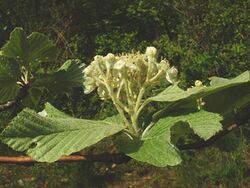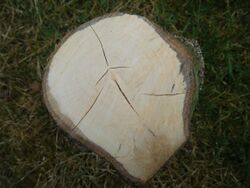Biology:Whitebeam
| Whitebeam | |
|---|---|

| |
| Common whitebeam flowers | |
| Scientific classification | |
| Kingdom: | Plantae |
| Clade: | Tracheophytes |
| Clade: | Angiosperms |
| Clade: | Eudicots |
| Clade: | Rosids |
| Order: | Rosales |
| Family: | Rosaceae |
| Genus: | Aria (Pers.) J.Jacq. ex Host |
| Synonyms | |
| |
The whitebeams are members of the family Rosaceae, comprising the genus Aria. They are deciduous trees with simple or lobed leaves, arranged alternately. They are related to the rowans, and many of the endemic restricted-range apomictic microspecies of whitebeam in Europe are thought to derive from hybrids between the common whitebeam and the European rowan. Some are also thought to be hybrids with the wild service tree, and the service tree of Fontainebleau found in French woodlands.
The best known species is the common whitebeam, a columnar tree which grows to 25 m (82 ft) tall by 10 m (33 ft) broad, with clusters of white flowers in spring followed by speckled red berries in autumn (fall).[1]
Appearance
The surface of the leaf is an unremarkable mid-green, but the underside is almost white (hence the name) transforming the appearance of the tree in strong winds, as noted by the poet Meredith: "flashing as in gusts the sudden-lighted whitebeam".[2] It is also described as the "wind-beat whitebeam" in Gerard Manley Hopkins' poem "The Starlight Night".[3]
Ecology
The berries are a favourite of birds, though less palatable (drier, less juicy) than rowan berries. Whitebeams are sometimes used as larval food plants by species of Lepidoptera, including the short-cloaked moth.[citation needed]
Uses

These trees are often grown in parks and large gardens. The cultivars A. edulis 'Lutescens'[4] and A. edulis 'Majestica' have gained the Royal Horticultural Society's Award of Garden Merit.[5]
The tough, hard wood is a deep orange when wet, and pale yellow after drying.[citation needed]
The fruit (a pome) is edible and is often made into jelly.[citation needed]
Taxonomy
The following species are recognised in the genus Aria:[6]
- Aria arvonicola (P.D.Sell) Sennikov & Kurtto
- Aria avonensis (T.C.G.Rich) Sennikov & Kurtto
- Aria baldaccii (C.K.Schneid.) Sennikov & Kurtto
- Aria busambarensis (G.Castellano, P.Marino, Raimondo & Spadaro) Sennikov & Kurtto
- Aria cambrensis (M.Proctor) Sennikov & Kurtto - Welsh whitebeam
- Aria cheddarensis (L.Houston & Ashley Robertson) Sennikov & Kurtto - Cheddar whitebeam
- Aria colchica (Zinserl.) Mezhenskyj
- Aria collina (M.Lepší, P.Lepší & N.Mey.) Sennikov & Kurtto
- Aria cucullifera (M.Lepší & P.Lepší) Sennikov & Kurtto
- Aria danubialis (Jáv.) Sennikov & Kurtto
- Aria edulis (Willd.) M.Roem.
- Aria eminens (E.F.Warb.) Sennikov & Kurtto - Round-leaved whitebeam
- Aria eminentiformis (T.C.G.Rich) Sennikov & Kurtto - Doward whitebeam
- Aria eminentoides (L.Houston) Sennikov & Kurtto - Twin Cliffs whitebeam
- Aria evansii (T.C.G.Rich) Sennikov & Kurtto
- Aria graeca (Lodd. ex Spach) M.Roem. - Balkan whitebeam
- Aria greenii (T.C.G.Rich) Sennikov & Kurtto
- Aria herefordensis (D.Green) Sennikov & Kurtto
- Aria hibernica (E.F.Warb.) Sennikov & Kurtto - Irish whitebeam
- Aria hungarica (Bornm.) Sennikov & Kurtto
- Aria javorkana (Somlyay, Sennikov & Vojtkó) Sennikov & Kurtto
- Aria keszthelyensis (Somlyay & Sennikov) Sennikov & Kurtto
- Aria lancastriensis (E.F.Warb.) Sennikov & Kurtto- Lancastrian whitebeam
- Aria leighensis (T.C.G.Rich) Sennikov & Kurtto - Leigh Woods whitebeam
- Aria × leptophylla (E.F.Warb.) Sennikov & Kurtto - Thin-leaved whitebeam
- Aria madoniensis (Raimondo, G.Castellano, Bazan & Schicchi) Sennikov & Kurtto
- Aria margaretae (M.Proctor) Sennikov & Kurtto - Margaret's whitebeam
- Aria meridionalis (Guss. ex Tod.) Raimondo & Greuter
- Aria moravica (M.Lepší & P.Lepší) Sennikov & Kurtto
- Aria obtusifolia (Ser.) Sennikov & Kurtto
- Aria orbiculata (Gabrieljan) Gabrieljan
- Aria pannonica (Kárpáti) Sennikov & Kurtto
- Aria parviloba (T.C.G.Rich) Sennikov & Kurtto - Ship Rock whitebeam
- Aria phitosiana Raimondo & Greuter
- Aria pontis-satanae (M.Lepší & P.Lepší) Sennikov & Kurtto
- Aria porrigentiformis (E.F.Warb.) Sennikov & Kurtto - Grey-leaved whitebeam
- Aria richii (L.Houston) Sennikov & Kurtto
- Aria × robertsonii (T.C.G.Rich) Sennikov & Kurtto
- Aria rupicola (Syme) Mezhenskyj - Rock whitebeam
- Aria rupicoloides (L.Houston & T.G.C.Rich) Sennikov & Kurtto - Gough's Rock whitebeam
- Aria saxicola (T.C.G.Rich) Sennikov & Kurtto - Symonds Yat whitebeam
- Aria spectans (L.Houston) Sennikov & Kurtto
- Aria stankovii (Juz.) Sennikov & Kurtto
- Aria stenophylla (M.Proctor) Sennikov & Kurtto - Llanthony whitebeam
- Aria stirtoniana (T.C.G.Rich) Sennikov & Kurtto - Stirton's whitebeam
- Aria subdanubialis (Soó) Sennikov & Kurtto
- Aria taurica (Zinserl.) Sennikov & Kurtto
- Aria tergestina (H.Lindb.) Sennikov & Kurtto
- Aria thaiszii (Soó) Sennikov & Kurtto
- Aria thayensis (M.Lepší & P.Lepší) Sennikov & Kurtto
- Aria ujhelyii (Somlyay & Sennikov) Sennikov & Kurtto
- Aria ulmifolia (Kárpáti) Sennikov & Kurtto
- Aria umbellata (Desf.) Sennikov & Kurtto
- Aria vajdae (Boros) Sennikov & Kurtto
- Aria vexans (E.F.Warb.) Sennikov & Kurtto - Bloody whitebeam
- Aria whiteana (T.C.G.Rich & L.Houston) Sennikov & Kurtto - White's whitebeam
- Aria wilmottiana (E.F.Warb.) Sennikov & Kurtto - Wilmott's whitebeam
- Aria yuarguta H.Ohashi & Iketani
- Aria zolyomii (Soó) Sennikov & Kurtto
References
- ↑ RHS A-Z encyclopedia of garden plants. United Kingdom: Dorling Kindersley. 2008. pp. 1136. ISBN 978-1405332965.
- ↑ Meredith, G. (1851). Love in the valley. Line 207. Poems
- ↑ Hopkins, Gerar Manley (1918). The starlight night. Line 6.
- ↑ "RHS Plant Selector - Sorbus aria 'Lutescens'". http://apps.rhs.org.uk/plantselector/plant?plantid=1852.
- ↑ "RHS Plant Selector - Sorbus aria 'Majestica'". http://apps.rhs.org.uk/plantselector/plant?plantid=4151.
- ↑ "Aria (Pers.) J.Jacq. ex Host | Plants of the World Online | Kew Science" (in en). http://powo.science.kew.org/taxon/urn:lsid:ipni.org:names:33661-1.
Wikidata ☰ {{{from}}} entry
 |
